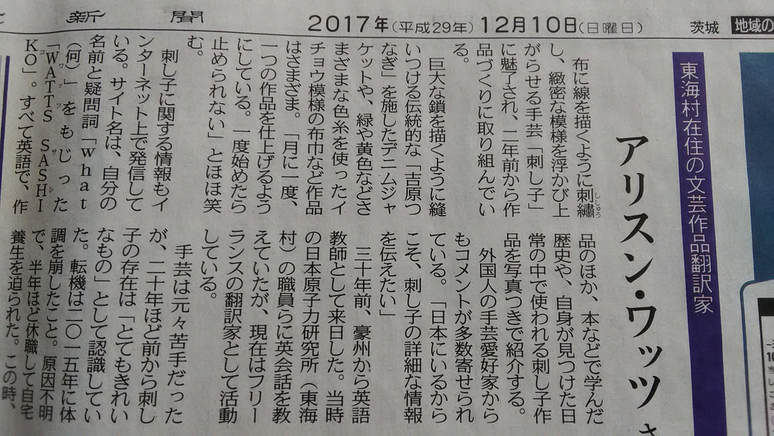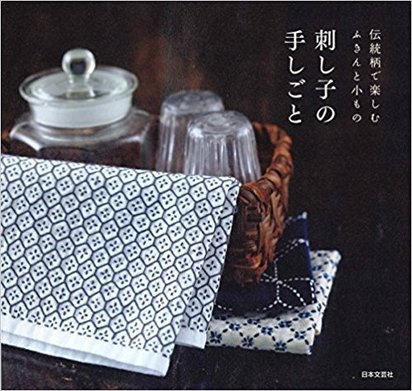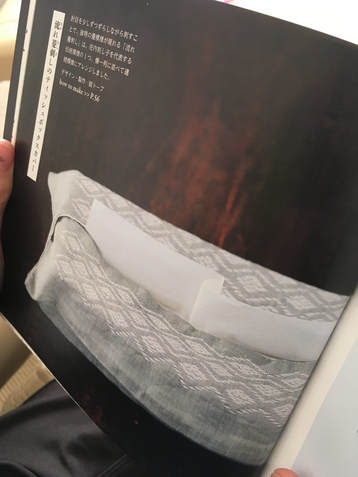|
This a translation of an article written by a journalist from the Tokyo Shimbun newspaper ( December 10th, 2017). It felt very strange to translate myself, but at least I could easily check the quotes with the source! Alison Watts (54). Literary Translator and Resident of Tokai-mura Alison Watts became fascinated by intricate sashiko patterns stitched on fabric and began making her own work two years ago. She makes about one piece a month, and has made items such as a denim jacket stitched with Yoshiwara tsunagi (large entwined chains), and a decorative cloth stitched in yellow and green gingko leaves. “Once I start I can’t stop” she says with a smile. Alison also writes about sashiko on the internet. On her Watts Sashiko website she introduces pieces she’s made, facts about sashiko she’s learned from Japanese books, reviews of books, as well as sashiko pieces she has found being used in daily life along with photos. Overseas fans of sashiko leave comments on her site. “I want to make the most of living in Japan and my language skills to provide the kind of information and detail about sashiko that is not available elsewhere,” she says. Alison came to Japan from Australia thirty years as an English teacher. She taught staff at the Japan Nuclear Research Institute (in Tokai-mura) but now works as a freelance Japanese to English translator. She became aware of the beauty of sashiko about twenty years ago, and although not very skilful at sewing or craftwork herself, bought some kits to try it. A turning point came, however, in 2015 when she became ill and couldn’t work as a translator for six months. While resting at home she began doing sashiko again and became completely absorbed by it, even starting to make her own pieces instead of using kits. “It was so soothing, and satisfying. I found that even a clumsy sewer like myself could still make things easily and enjoy it,” she recalls.
Alison turned the experience of being ill into an opportunity to change her life. She began pursuing her passion for sashiko when she recovered, by joining a sashiko group in the town, and starting up a website and blog. This month she opened an online shop on her website, which is selling sashiko kits sourced from a Nagoya-based craft company. The kits contain English instructions she translated herself. “Sashiko is growing in popularity as it becomes more and more widely known overseas,” says Alison who senses a need for more literature in English, as there is very little available. “I think it’s because sashiko is beautiful and easy to do. It’s a craft that anybody can enjoy. You don’t need to be an expert sewer,” she says. Alison Watts. Born in South Australia, October 1963. A literary translator by trade, she has translated Durian Sukegawa’s novel An (English title: Sweet Bean Paste). She also produces poetry and music concerts, and in February produced a concert in Tokai-mura to mark the sixth anniversary of the 2011 disasters. The concert featured Durian Sukegawa’s performance of “A New Road to the Far North,” the record of a journey he undertook six years ago by bicycle, travelling in the footsteps of poet Matsuo Basho and measuring radiation along the way in disaster-ravaged areas.
2 Comments
I’ve been busy getting the online shop ready and haven’t had much time for writing recently (or doing sashiko!), but here’s a review of a book I wanted to tell you about. Also, if you haven’t already ordered, don’t forget to take a look at the three-kit subscription set I’m taking orders for at the moment in my shop.. Anyway, the latest addition to my collection of sashiko books is this neat little volume published by Nihon Bungeisha in October. Sashiko no Teshigoto (Sashiko Handiwork - Amazon Japan affiliate link) is a collection of beautifully photographed fukin and other small handiwork items — such as a tissue box cover, purse, bag and coasters — with instructions on how to make them. As so often happens, when I bought this book and flicked through I immediately wanted to make everything, which of course I don’t have time for. But even if that’s not possible, I still get a lot of enjoyment from simply looking at photographs of beautiful sashiko stitching, and in that respect this book is very satisfying. It could easily be a coffee table book as the photography is lovely. The sashiko handiwork is displayed on mostly dark wood or light backgrounds, in tasteful minimalist settings with only an iron teapot or cane basket as an accent, and the overall effect is traditional yet modern, an accurate reflection of the sashiko items themselves: conventional but with an elegant, contemporary touch. For example, the white hanafukin with a cross flower stitch in charcoal grey, and one red flower in the corner. Or the chic tissue box cover with nagare hishizashi stitched in white on pale grey cotton. One reason I like this book is that it retains an emphasis on the traditional blue and white combination, while offering an updated version with subtle variations on that theme. As with many sashiko books it follows a standard format of introducing a number of sample pieces (in this case twenty), then providing samplers of the stitches, basic instructions on how to do sashiko (with explanations about cloth, thread, equipment, drafting, stitching and making two easy pieces), and instructions for making up each individual item. The stitches are introduced in four categories; straight line patterns such as tobi asanoha (scattered hemp leaf), curved line patterns such as fundo tsunagi (linked weights), hitomezashi such as kaki no hana (persimmon flower), and Shonai sashiko such as ganzezashi (sea urchin stitch). The last, ganzezashi, is one of my most favourite stitches. It could have something to do with the fact that sea urchin is my favourite sushi topping… but I also love the convergence of concentric lines that scream out to me sashiko! Stitched in white on blue cloth, this hanafukin is totally mesmerizing. Next to making it myself, a photograph is the next best thing.
|
Watts SashikoI love sashiko. I love its simplicity and complexity, I love looking at it, doing it, reading about it, and talking about it. Archives
September 2022
Categories
All
Sign up for the newsletter:
|










 RSS Feed
RSS Feed



